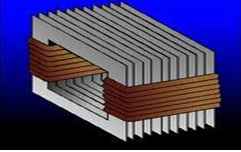A transformer is an electrical device that takes electricity of one voltage and changes it into another voltage.
Types of transformer:
Ø Step up
Ø Step down
Ø Isolating
Ø Variable etc.
In power station, step up transformers are used to up the voltage and minimize transmission loss.
Step up transformer:
The transformer in which voltage is increased is called step up transformer. Here the secondary has more turns than the primary winding.Figure: Transformer.
Main parts of transformer:
Ø Transformer shell
Ø Inner core
Ø Oil reservoir
Ø Cooling system
Ø Bushing
Transformer shell:
It is a shell generally made of cast iron or steel. It holds all the equipments inside of shell. In this sense it is an outer casing of transformer.
Inner core:
Inner core means the main core of parallel plates arranged into the transformer shell. There are two types of wingdings, primary and secondary.

fig - transformer core and windings.
Oil reservoir:
It is a reservoir which keeps the oil reserved for cooling of transformer.
Cooling system:
In cooling system, oil is used to cool the inner core of transformer by absorbing internal heat. Then this oil is cooled by circulating air. In air cooling system, there are fans and radiators to cool the hot oil. Oil flow through the radiators and air is blown across the radiators to cool the oil. Then the cooled oil is returned to transformer oil reservoir.
Bushing:
Bushings are insulated bars or wires that connected the transformer with other electrical equipment’s. It is usually filled with oil to provide extra insulation. To prevent faults, non-conducting gaskets are used with the bushing of transformer.